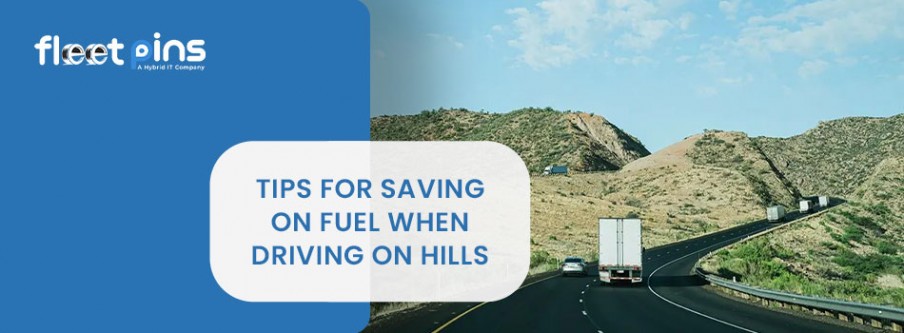
- On 2024-10-08
Tips for Saving on Fuel When Driving on Hills
Driving on hills can significantly impact your vehicle's fuel efficiency, as the constant climbing and descending of slopes puts extra strain on the engine. For fleet operators or individual drivers, managing fuel consumption is crucial, especially when tackling steep and winding roads. However, by adopting a few smart driving strategies, you can minimize fuel consumption, reduce costs, and ensure smoother trips. Fleet Pins will guide us on various tips for saving fuel when driving on hills.
Smart Driving Techniques to Reduce Fuel Usage on Hills
Driving on hilly terrain requires different techniques compared to flat roads. The key to saving fuel lies in smart driving strategies that reduce strain on the engine, optimize vehicle momentum and minimize unnecessary fuel use. Here are some effective tips for how can you save fuel while driving on hills:
1. Maintain a Consistent Speed
When driving uphill, many drivers tend to accelerate hard to maintain speed, which can cause the engine to consume more fuel. Instead, it’s more efficient to maintain a steady speed, even if that means allowing the vehicle to slow down slightly as you ascend. By avoiding sharp acceleration and maintaining a constant throttle, you’ll reduce fuel consumption significantly.
2. Shift to Lower Gears When Needed
When climbing steep hills, shifting to a lower gear can help your vehicle manage the incline more easily. However, it's important not to over-rev the engine by staying in a lower gear for too long. Find a balance where the engine runs smoothly without putting excessive strain on the vehicle. This allows you to maintain control while avoiding the fuel waste that occurs when the engine is revving too high.
3. Utilize Momentum on Downhill Stretches
When descending hills, let gravity do the work. Take your foot off the accelerator and allow the vehicle to coast downhill where it’s safe and possible. This reduces engine workload and conserves fuel. However, always keep safety in mind and use the brakes, when necessary, especially if the slope is steep or winding.
4. Plan Your Route for Fuel Efficiency
One of the simplest ways to save fuel on hills is to plan your route in advance. If possible, choose routes that avoid steep inclines or have more gradual slopes. Some GPS systems and fleet management tools can help you find the most fuel-efficient routes, which can make a big difference in hilly areas.
You May Also Read: What is the Best Fleet Safety Training? Essential Components and Tips
How Fleet Management Software Helps Optimize Fuel Usage
Fleet management software plays a crucial role in helping businesses reduce fuel consumption, particularly when dealing with challenging terrains like hills. Here's how fleet management software can assist in cutting fuel costs:
Route Optimization for Fuel Efficiency
Fleet management software uses AI and GPS to optimize routes, ensuring that vehicles take the most efficient path to their destination. By avoiding unnecessary hills or steep terrain, the software helps drivers save on fuel by keeping them on more level and less demanding roads.
Monitoring Driver Behavior
Poor driving habits like harsh acceleration, speeding, and improper gear shifting can waste fuel. Fleet management software monitors these behaviors in real-time, allowing fleet managers to coach drivers on more fuel-efficient techniques. Alerts for harsh braking, aggressive driving, or unnecessary idling help reduce fuel consumption.
Vehicle Maintenance Alerts
Well-maintained vehicles perform better on hills. Fleet management software tracks vehicle maintenance schedules, ensuring that your fleet is in top condition. Regular tune-ups, proper tire pressure, and timely oil changes all contribute to better fuel efficiency, especially when tackling hilly terrain.
Detailed Fuel Consumption Reports
Fleet management software offers detailed fuel usage reports, allowing fleet managers to track which vehicles or drivers are consuming the most fuel. These insights enable companies to address inefficiencies, adjust driving practices, and ultimately save money on fuel.
You May Also Read: Top Benefits of Implementing GPS Trackers in Fleet Operations
Choose Fleet Pins for the Best Fleet Management Software
When it comes to reducing fuel costs, Fleet Pins stands out as one of the best fleet management solutions available. Designed to optimize fleet operations, Fleet Pins offers comprehensive features that help manage everything from route planning to real-time driver behavior monitoring.
- Advanced Route Planning
- Driver Performance Insights
- Predictive Maintenance
- Fuel Consumption Reports
This data allows fleet managers to make informed decisions, such as planning better routes, optimizing driver training, and improving vehicle maintenance.
You May Also Read: Benefits of Dash Cams for Fleet Vehicles
Conclusion: Save Fuel While Driving on Hilly Terrain
Driving on hills can put a significant strain on your vehicle’s fuel consumption, but with the right techniques and tools, you can minimize fuel costs. By maintaining a steady speed, using lower gears properly, and leveraging downhill momentum, you can save fuel while driving on hilly terrain.
Fleet management software like Fleet Pins takes fuel savings to the next level by providing route optimization, monitoring driver behavior, and offering real-time insights. If you're looking to cut down on fuel costs, especially in hilly regions, investing in a top-tier fleet management solution like Fleet Pins is an excellent choice. It will help your fleet become more efficient, save money, and reduce wear on your vehicles.




